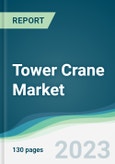The global tower crane market was valued at US$11.917 billion in 2021.
A tower crane is a lifting equipment used for lifting heavy loads and materials to heights that are difficult to reach using other types of cranes, and it consists of a vertical mast, a horizontal jib, and a counterweight. Tower cranes are particularly useful in urban areas where space is limited, as tower cranes do not require large amounts of space for their operation. The tower crane is used in construction and energy & power plant applications. The tower crane market is driven by increasing demand for tall and complex buildings, energy and power, and rapid urbanization.The growing construction activities and increasing investments in energy & power projects are boosting the tower crane market growth.
The demand for the construction of high-rise buildings, bridges, airports, residential and commercial buildings, and other large structures is increasing due to population growth, urbanization, and industrialization. The construction of these structures requires specialized lifting equipment like tower cranes, which can lift materials such as steel, concrete, and precast components to heights of up to 800 meters. Tower cranes play a crucial role in the construction industry by lifting and transporting heavy loads, and the demand for tower cranes is increasing with the growth of construction activities. According to the American Road and Transportation Builders Association (ARTBA), on January 30, 2023, states committed $7.2 billion in highway and bridge formula funds to support over 7,400 new projects, and this was in addition to $53.5 billion in investment and over 29,000 new projects supported in FY 2022. The Global Infrastructure Outlook by the Global Infrastructure Hub estimated that the total infrastructure investment needed by 2040 is around $94 trillion, with the majority of this investment needed in Asia, particularly in China and India. According to the International Association for Bridge Maintenance and Safety (IABMAS) report in 2021, approximately 42% of bridges are at least 50 years old and require significant maintenance and renovation. Approximately 231,000 bridges need repair, with an estimated cost of $125 billion. Energy and power plants often require large-scale infrastructure projects that involve the construction of heavy-duty structures, such as power plants, substations, and wind turbines, and these projects require the use of tower cranes to lift heavy loads and equipment to high elevations, making tower cranes an essential tool for the energy and power industry. The demand for tower cranes is expected to continue to rise with the growing demand for energy and power. The Borkum Riffgrund offshore wind farm in Germany project began construction in 2021 and is expected to be completed in 2025, which will have a capacity of 900 MW and is being built by Orsted. The project is expected to provide clean energy to around 1 million households in Germany. This demonstrates that the tower crane holds a great demand in the future demand.The Asia Pacific region hold a significant share of the market in 2021.
The Asia Pacific region holds a significant market share of tower cranes market due to the rapid urbanization, growing infrastructure development, and construction activities in countries like China, India, and Southeast Asian nations. In 2020, China launched several mega-infrastructure projects, such as the expansion of the Beijing Daxing International Airport and the Hong Kong-Zhuhai-Macau Bridge. The Indian government announced the development of Ultra Mega Renewable Energy Power Parks (UMREPPs) in 2020, which aims to set up large-scale renewable energy parks across the country, and the project involves the construction of solar and wind power plants. Vietnam launched the National Target Program on new rural development in 2021, which includes the construction of new infrastructure such as bridges and public buildings, and the program has been allocated a budget of VND 43 trillion (US$1.8 billion). Such project establishment will boost the requirement for tower cranes in the Asia Pacific, thereby boosting the regional market growth.Market Developments:
- July 2022: Liebherr announced the launch of its new 300 EC-B 126 Litronic flat-top tower crane with a maximum lifting capacity of 12 tonnes and a hook height of 92 meters which was economical due to simple transport and had a fast erection.
- January 2022: Wolffkran launched a new Wolff 8076 with a low-top tower head design with a maximum lifting capacity of 40 tonnes and a maximum jib length of 80 meters and had better visibility on job sites and easier transportation.
- July 2021: Manitowoc launched its new Potain MCT 565 topless tower crane designed to improve productivity and efficiency on job sites with its improved lifting capacity and reach.
Market Segmentation:
By Type
- Hammerhead
- Luffing Tower Crane
- Self-Erecting Tower Crane
By End-User
- Construction
- Energy & Power
By Geography
- North America
- USA
- Canada
- Mexico
- South America
- Brazil
- Argentina
- Others
- Europe
- Germany
- UK
- France
- Spain
- Others
- Middle East and Africa
- Saudi Arabia
- UAE
- Others
- Asia Pacific
- China
- Japan
- South Korea
- India
- Australia
- Others
Table of Contents
1. INTRODUCTION
2. RESEARCH METHODOLOGY
3. EXECUTIVE SUMMARY
4. MARKET DYNAMICS
5. TOWER CRANE MARKET BY TYPE
6. TOWER CRANE MARKET BY END-USER
7. TOWER CRANE MARKET BY GEOGRAPHY
8. COMPETITIVE ENVIRONMENT AND ANALYSIS
9. COMPANY PROFILES
Companies Mentioned
- Everest Equipment Pvt Ltd.
- JASO Group
- Liebherr
- Manitowoc Company Inc.
- SANNY Group
- Terex Corporation
- XCMG Group
- ZOOMLION Heavy Industry Sciences & Technology Co. Ltd
Methodology

LOADING...








